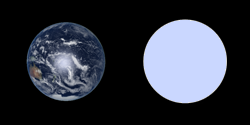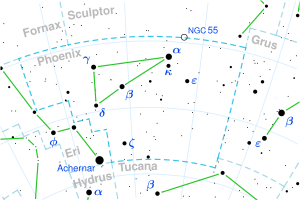 Size of WD 2359−434 in comparison with Earth. On the left is Earth, on the right is WD 2359-434. | |
| Observation data Epoch J2000 Equinox J2000 | |
|---|---|
| Constellation | Phoenix |
| Right ascension | 00 02 10.72420 |
| Declination | −43° 09′ 55.3906″ |
| Apparent magnitude (V) | 12.76 |
| Characteristics | |
| Spectral type | DAP5.8 |
| Apparent magnitude (B) | 13.12 |
| Apparent magnitude (V) | 12.76 |
| Apparent magnitude (RKC) | 12.82 |
| Apparent magnitude (IKC) | 12.66 |
| Apparent magnitude (J) | 12.60 ± 0.03 |
| Apparent magnitude (H) | 12.43 ± 0.02 |
| Apparent magnitude (KS) | 12.45 ± 0.02 |
| Astrometry | |
| Radial velocity (Rv) | -58.8 ± 10.8 km/s |
| Proper motion (μ) | RA: 613.785 mas/yr Dec.: -686.989 mas/yr |
| Parallax (π) | 120.0143 ± 0.0215 mas |
| Distance | 27.176 ± 0.005 ly (8.332 ± 0.001 pc) |
| Absolute magnitude (MV) | 13.20 |
| Details | |
| Mass | 0.85 ± 0.01 M☉ |
| Radius | 0.0097 R☉ |
| Surface gravity (log g) | 8.39 ± 0.01 cgs |
| Temperature | 8570 ± 50 K |
| Age | 1.82 ± 0.06 Gyr |
| Other designations | |
| GJ 915, EGGR 165, L 362-81, LAWD 96, LFT 1849, LHS 1005, LP 988-88, LTT 9857, WD 2359-434, 2MASS J00021076-4309560 | |
| Database references | |
| SIMBAD | data |
 | |
WD 2359-434 (Gliese 915, LHS 1005, L 362-81) is a nearby degenerate star (white dwarf) of spectral class DAP5.8, the single known component of the system, located in the constellation Phoenix, the nearest star in this constellation.
Distance
Currently, the most accurate distance estimate of WD 2359−434 is a trigonometric parallax from Gaia DR3: 120.0143±0.0215 mas, corresponding to a distance of 8.332±0.001 pc, or 27.176±0.005 ly. WD 2359−434 is the 13th closest white dwarf to the Sun.
Physical parameters
WD 2359−434's mass is 0.85 ± 0.01 Solar masses, its surface gravity is 10 (2.45 · 10) cm·s, or approximately 250,000 of Earth's, corresponding to a radius 6780 km, or 1.06 of Earth's.
WD 2359−434 is relatively hot and young white dwarf, its temperature is 8570 ± 50 K; its cooling age, i. e. age as degenerate star (not including lifetime as main sequence star and as giant star) is 1.82 ± 0.06 Gyr. Gliese 518 should appear bluish-white, due temperature, comparable with that of A-type main sequence stars.
As all white dwarfs, WD 2359−434 is composed of very dense degenerate matter, its mean density is 1,300,000 g·cm, i.e. mass of one cubic millimetre of WD 2359−434 matter is 1.3 kg.
Unusually for a white dwarf star, WD 2359-434 has a weak, non-dipole magnetic field of 50,000 - 100,000 Gauss.
Main sequence progenitor properties
As all degenerate stars, WD 2359−434 previously existed initially as main-sequence star and then as giant star, until all the thermonuclear fuel was exhausted, after which WD 2359−434 lost most of its mass. According to the 2010 thesis for the degree of Doctor of Science, using Wood model D initial–final mass relation and WD 2359−434's white dwarf mass value 0.97 ± 0.03 M☉ from Holberg et al. 2008, its main sequence progenitor mass was 7.09 M☉. Using expression for pre-white dwarf lifetime 10 · (MMS/M☉) (Gyr), was found WD 2359−434 main sequence age 0.07 Gyr.
White dwarf mass value 0.85 ± 0.01 M☉ from Subasavage et al. 2009, in Wood model D yields MS (main sequence) mass 6.03 M☉, and MS lifetime 0.11 Gyr, corresponding to B-type main sequence star.
According to initial-final mass relation from Weidemann 2000 paper, WD 2359−434's main sequence progenitor should have mass about 4.6 M☉ and lifespan 0.22 Gyr, and, again, should be of B spectral type. There are also other models.
See also
Notes
- From apparent magnitude and parallax.
- From surface gravity and mass.
- White dwarf cooling age, i. e. age as degenerate star (not including lifetime as main sequence star and as giant star).
- From mass and surface gravity (assuming spherical shape).
References
- ^ "GJ 915 -- White Dwarf". Centre de Données astronomiques de Strasbourg. Retrieved 2011-11-03.
- ^ Vallenari, A.; et al. (Gaia collaboration) (2023). "Gaia Data Release 3. Summary of the content and survey properties". Astronomy and Astrophysics. 674: A1. arXiv:2208.00211. Bibcode:2023A&A...674A...1G. doi:10.1051/0004-6361/202243940. S2CID 244398875. Gaia DR3 record for this source at VizieR.
- ^ Holberg, J. B.; Sion; Oswalt; McCook; Foran; Subasavage (2008). "A New Look at the Local White Dwarf Population". The Astronomical Journal. 135 (4): 1225–1238. Bibcode:2008AJ....135.1225H. doi:10.1088/0004-6256/135/4/1225. S2CID 122855486.
- ^ Sion, Edward M.; Holberg; Oswalt; McCook; Wasatonic (2009). "The White Dwarfs within 20 Parsecs of the Sun: Kinematics and Statistics". The Astronomical Journal. 138 (6): 1681–1689. arXiv:0910.1288. Bibcode:2009AJ....138.1681S. doi:10.1088/0004-6256/138/6/1681. S2CID 119284418.
- ^ Subasavage, John P.; Jao; Henry; Bergeron; Dufour; Ianna; Costa; Mendez (2009). "THE SOLAR NEIGHBORHOOD. XXI. PARALLAX RESULTS FROM THE CTIOPI 0.9 m PROGRAM: 20 NEW MEMBERS OF THE 25 PARSEC WHITE DWARF SAMPLE". The Astronomical Journal. 137 (6): 4547–4560. arXiv:0902.0627. doi:10.1088/0004-6256/137/6/4547. S2CID 14696597.
- Pauli, E.-M.; Napiwotzki; Heber; Altmann & Odenkirchen (2006). "3D kinematics of white dwarfs from the SPY project. II". Astronomy and Astrophysics. 447 (1): 173–184. arXiv:astro-ph/0510494. Bibcode:2006A&A...447..173P. doi:10.1051/0004-6361:20052730. S2CID 14250519. (see Table 8)
- Reylé, Céline; Jardine, Kevin; Fouqué, Pascal; Caballero, Jose A.; Smart, Richard L.; Sozzetti, Alessandro (30 April 2021). "The 10 parsec sample in the Gaia era". Astronomy & Astrophysics. 650: A201. arXiv:2104.14972. Bibcode:2021A&A...650A.201R. doi:10.1051/0004-6361/202140985. S2CID 233476431. Data available at https://gruze.org/10pc/ Archived 12 March 2023 at the Wayback Machine
- Landstreet, J. D.; Bagnulo, S.; Valyavin, G.; Valeev, A. F. (2017), "Monitoring and modelling of white dwarfs with extremely weak magnetic fields", Astronomy & Astrophysics, 607: A92, arXiv:1709.04099, doi:10.1051/0004-6361/201731432, S2CID 119502643
- Matías Cristóbal Radiszcz Sotomayor, BINARIEDAD ESTELAR Y SUB-ESTELAR EN ENANAS BLANCAS CERCANAS
- ^ Wood, M. A. (1992). "Constraints on the age and evolution of the Galaxy from the white dwarf luminosity function". The Astrophysical Journal. 386: 539–561. Bibcode:1992ApJ...386..539W. doi:10.1086/171038.
- Weidemann, V. (2000). "Revision of the initial-to-final mass relation". Astronomy and Astrophysics. 363: 647–656. Bibcode:2000A&A...363..647W.
| Constellation of Phoenix | |||||||||||
|---|---|---|---|---|---|---|---|---|---|---|---|
| Stars |
| ||||||||||
| |||||||||||
| Galaxies |
| ||||||||||
| |||||||||||